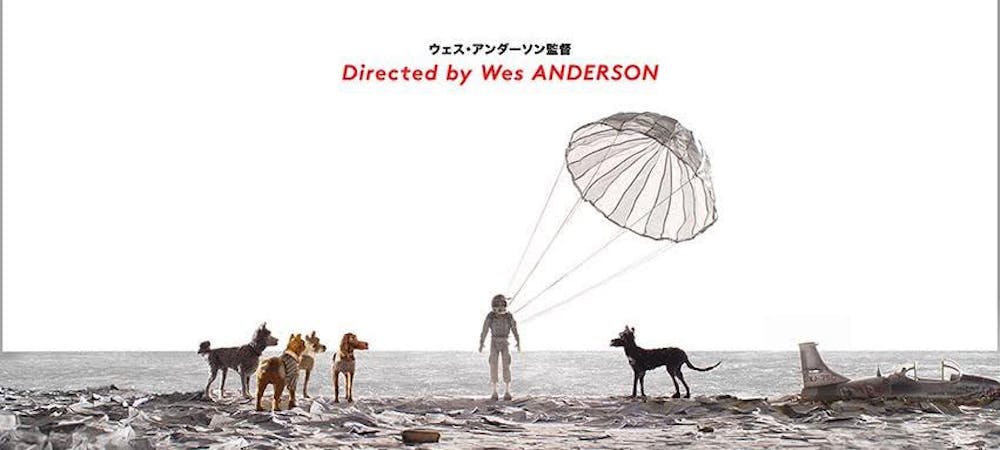After a four–year hiatus since the acclaimed The Grand Budapest Hotel, Wes Anderson steps back into the public spotlight with Isle of Dogs. His second animated movie tells the story of a group of dogs who try to escape oppression in an authoritarian, dystopian, fictionalized Japan. If the premise doesn’t sound enticing enough, it might be because it’s inevitably reminiscent of a children’s movie. As a 20–year–old, I must admit it was the name of the director, rather than his marketing strategy, that eventually convinced me to watch. However, Isle of Dogs is in no way childish—if anything, it’s Anderson’s most mature work to date.
Stylistically, Isle of Dogs is impeccable with its seamless stop–motion animation and carefully–crafted cinematic environment. What other directors might see as a coherent, narrative sequence, Anderson cuts out, embellishes, and mounts as a series of vignettes that peek into a miniature world. It was a risky move in terms of unity, but complemented Anderson’s already visually–stunning shots. These highly–stylized vignettes do come together eventually, as much as the plot allows it.
Isle of Dogs tells the story of Atari, the 12–year–old nephew of Megasaki’s mayor Kobayashi, who goes looking for his long–lost dog Spot on an island where his uncle had exiled the city’s entire canine population. Unfortunately, the subsequent plot development is simple and predictable, which is perhaps my only criticism of the film. On the other hand, amidst the flurry of rapid camera movements and flashy décors, a more complicated plot line would have made the movie overpowering.
Perhaps the most typical character in Isle of Dogs is Kobayashi, who turns out to be representative of the “political villain.” He doesn’t only orchestrate the creation of a virus which, if spread, would allow him to advance politically, but he also exiles, mocks, or just kills whomever gets in his way. Add to that his rash “military” decisions, ignorance of environmental guidelines, and stubbornness, and you’ve got an obvious Trump–Putin hybrid which ultimately provides many of the movie’s gags, while also accounting for its dystopian atmosphere.
I saw Isle of Dogs a couple of days after its public release, so I walked into the theater fully aware of the movie’s greatest criticism. Political references aside, many had already questioned Anderson’s choice of setting, arguing that he uses Japanese culture as a mere plot device and inevitably accusing Anderson of cultural appropriation. Such dialogue is more than welcome, and Anderson’s critics might have a point—but I don’t think such harshness is necessary. It’s true that Anderson’s oeuvre has obvious fetishist tendencies, particularly when it comes to details, and notoriously, to symmetry. What’s also true is that Anderson is an explorer—and it’s this quality, paired with his aestheticization of (everything) kitsch, that eventually gives his movies the easily recognizable sense of eclecticism that is so characteristic of his work. Isle of Dogs doesn’t reduce Japan to a carefully–polished surface any more than Blade Runner or Lost in Translation do—and while it’s arguably a lot funnier, it never crosses the line between pastiche and parody.
To parody Japanese culture would have implied either pointing fingers at what it values, or to reduce it to its aesthetic. But the director never does any of that—on the contrary, his choice of Japanese actors for the voices of most human characters allows for dialogue that blends effortlessly into the background, and for an obvious desire for most viewers to empathize not with the humans, but with the dogs. Indeed, in the typical Andersonian fashion, it’s the combination of pastiche and fetishism—particularly obvious in a perfectly symmetrical, aesthetically–pleasing sushi–making sequence—that makes Isle of Dogs a masterpiece. The comic aspects never even touch on any culture in particular. In fact, I thought most of the humor—and this is arguably the funniest movie that I’ve ever seen—sprang from Anderson’s tongue–in–cheek, self–referential mockery, as well as from the intentionally aloof lines delivered impeccably by a long list of talented actors such as Tilda Swinton, Bill Murray, Scarlett Johansson, and Edward Norton, among many others.
It might be that my affinity for Anderson’s dryness tipped the scales in his favor, but I believe Isle of Dogs is the best film currently showing in theaters, and perhaps the best release of 2018 to date. A childish premise turned into a hilarious parody, the movie is bound to entertain viewers of all ages. But, if dry humor or witty political references are not your thing, you’ll definitely enjoy the aesthetic—and the dogs.
Rating: 4/5
‘Isle of Dogs’ is currently showing at the Ritz Five.

